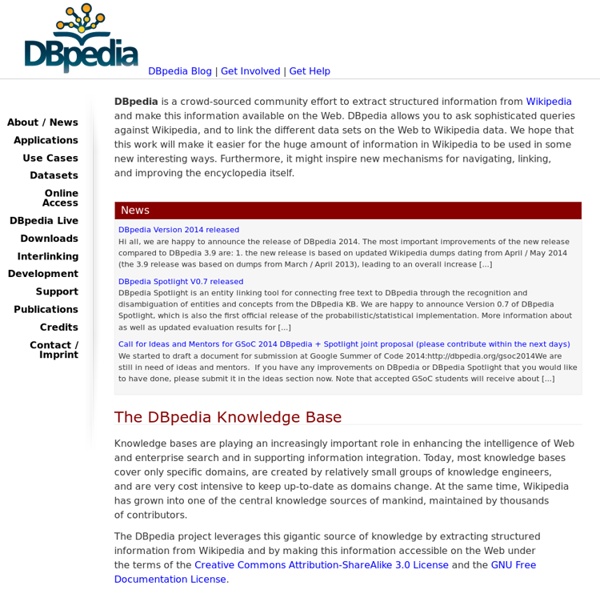



SPARQL Endpoint interface to Python This is a wrapper around a SPARQL service. It helps in creating the query URI and, possibly, convert the result into a more manageable format. The package is licensed under W3C license, and it can be downloaded in .zip and .tar.gz formats from GitHub, also from PyPi or from Debian, and eventually from SourceForge where was previously hosted. The following packages are used: for JSON, the simplejson package (for Python < 2.6) for RDF, the RDFLib package These packages are imported in a lazy fashion, ie, only when needed. Developers involved: Here you have an example of how to use the library in your python program: You can also read online documentation for more information, or contact us at the rdflib-dev; the archives from the old mailing list are still available.
Startup America: A Campaign To Celebrate, Inspire And Accelerate Entrepreneurship Note from the editor: This is a guest post from Aneesh Chopra, United States Chief Technology Officer. During last week’s State of the Union address, President Obama challenged the Nation to out-educate, out-innovate, and out-build our competition to win the future. A critical ingredient in this endeavor is the creative spirit of the American entrepreneur that featured prominently in the President’s Strategy for American Innovation – a framework for long-term economic growth and sustainable job creation. Today, President Obama celebrated the launch of Startup America, a national (public/private) campaign to celebrate, inspire, and accelerate high-growth entrepreneurship across all corners of the country, and the formation of the Startup America Partnership to catalyze private support for entrepreneurial ecosystems. To kick-start the campaign, the Obama Administration announced 27 public and private commitments organized across five key goals: 1. Stay tuned. 2. 3. 4. 5.
How to publish Linked Data on the Web This document provides a tutorial on how to publish Linked Data on the Web. After a general overview of the concept of Linked Data, we describe several practical recipes for publishing information as Linked Data on the Web. This tutorial has been superseeded by the book Linked Data: Evolving the Web into a Global Data Space written by Tom Heath and Christian Bizer. This tutorial was published in 2007 and is still online for historical reasons. The goal of Linked Data is to enable people to share structured data on the Web as easily as they can share documents today. The term Linked Data was coined by Tim Berners-Lee in his Linked Data Web architecture note. Applying both principles leads to the creation of a data commons on the Web, a space where people and organizations can post and consume data about anything. The Web of Data can be accessed using Linked Data browsers, just as the traditional Web of documents is accessed using HTML browsers. Literal Triples RDF Links 3.
YAGO2 - D5: Databases and Information Systems (Max-Planck-Institut für Informatik) Overview YAGO is a huge semantic knowledge base, derived from Wikipedia WordNet and GeoNames. Currently, YAGO has knowledge of more than 10 million entities (like persons, organizations, cities, etc.) and contains more than 120 million facts about these entities. YAGO is special in several ways: The accuracy of YAGO has been manually evaluated, proving a confirmed accuracy of 95%. YAGO is developed jointly with the DBWeb group at Télécom ParisTech University.
Wiki-Incubator! OWL API 63 EdTech Resources You May Have Missed–Treasure Chest, Feb. 6, 2011 Here is this week’s edition of Treasure Chest–63 EdTech Resources You May Have Missed. I know, that’s a lot! What’s funny though is that I thought this week would bring my fewest number of resources. Due to time constraints this week, I didn’t think I was doing a very good job of curating resources. I would also like to thank Larry Ferlazzo for including this blog in his “The Best Blogs…” category. “Tech The Plunge” Is A Blog Worth Reading | Larry Ferlazzo’s Websites of the Day…–Tech The Plunge is an excellent resource-sharing blog written by Jeff Thomas. On with the show! Featured Tom Barrett’s Interesting Ways Series—All in One Location!!! Tools How-To iPad, iPod, etc. My Favorite iPad Apps–If you are curious to know what apps have I installed on my iPad, check these interactive screenshots for a complete list of my favorite iPad apps.smartr for iPhone, iPod touch, and iPad on the iTunes App Store–Smartr’s the fastest way to get your news on Twitter. Miscellaneous Videos Teach Different
Jena Semantic Web Framework Graph | UMBEL The core UMBEL ontology now contains about 26,000 reference concepts organized according to 33 super types. There are more than 60,000 relationships amongst these concepts, resulting in a graph structure of very large size. It is difficult to grasp this graph in the abstract. Thus, using methods earlier described in our use of the Gephi visualization software [1], we present below a dynamic, navigable rendering of this graph of UMBEL core: Note: at standard resolution, if this graph were to be rendered in actual size, it would be larger than 34 feet by 34 feet square at full zoom !!! This UMBEL graph displays: You may also want to inspect a static version of this big graph by downloading a PDF.
WikiLabs Linked Data | Linked Data - Connect Distributed Data across the Web